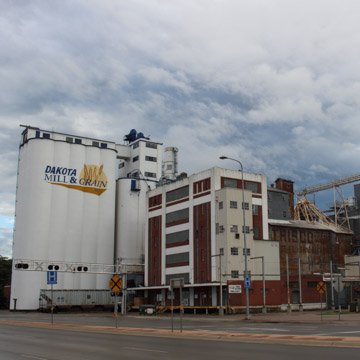You are here
Dakota Mill and Grain
The Dakota Mill and Grain facility is located in downtown Rapid City on the south bank of Rapid Creek, adjacent to the rail lines on the east and south.
Originally begun as the Tri-State Milling Company, construction on the facility began in 1937 and was completed the following year. The T.E. Ibberson Company of Minneapolis (a city that had been a center for flour milling for decades) designed and built the plant, which included a concrete grain elevator, warehouse, and six-story feed mill equipped with up-to-date machinery. The feed mill, which produced 600 barrels of flour a day, is an architectural composition of horizontal and vertical lines, forming a gridded pattern. The center bay of the reinforced concrete and brick structure features large, rectangular glass-block windows on each level; two vertical strips of glass-block windows are on the outer bays. Vertical concrete piers run the fill height of the building, separating the bays, and the top floor is set off by a horizontal concrete band. A fluted cornice caps the composition, lending an elegance to the industrial building.
The mill expanded following World War II, and by the 1960s was producing 2,700 100-pound bags per day. The mill expanded again in 1965 with the construction of eight large feed storage tanks and a modern dispensing system. Tri-State went on to become one of the largest and most successful milling companies in South Dakota. In 1970, Tri-State was sold to Hubbard Milling Company of Mankato, Minnesota, and then to Dakota Grain and Feed, which operates the mill today.
References
Writing Credits
If SAH Archipedia has been useful to you, please consider supporting it.
SAH Archipedia tells the story of the United States through its buildings, landscapes, and cities. This freely available resource empowers the public with authoritative knowledge that deepens their understanding and appreciation of the built environment. But the Society of Architectural Historians, which created SAH Archipedia with University of Virginia Press, needs your support to maintain the high-caliber research, writing, photography, cartography, editing, design, and programming that make SAH Archipedia a trusted online resource available to all who value the history of place, heritage tourism, and learning.

